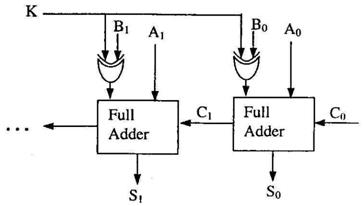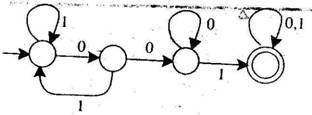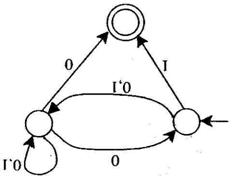CSE GATE sample paper
Printed From: One Stop GATE
Category: GATE Previous Years Test Papers - Discuss Here
Forum Name: CS Papers
Forum Discription: Computer Science Previous Year GATE Papers to can discussed here.
URL: http://forum.onestopgate.com/forum_posts.asp?TID=82
Printed Date: 19Sep2025 at 6:05am
Topic: CSE GATE sample paper
Posted By: Arpita
Subject: CSE GATE sample paper
Date Posted: 05Jan2007 at 5:56pm
|
1. Consider the ALU shown below.
If the operands are in 2's complement representation, which of the following operations can be performed by suitably setting the control lines K and C o only (+ and -denote addition and subtraction respectively)?
(d) A+ B, and A-B, and A+ 1 2. Consider the following circuit composed of XOR gates and non-inverting buffers.
The non-inverting buffers have delays d 1 = 2 ns and d 2 = 4 ns as shown in the figure. Both XOR gates and all wires have zero delay. Assume that all gate inputs, outputs and wires are stable at logic level 0 at time 0. If the following waveform is applied at input A, how many transition(s) (change of logic levels) occur(s) at B during the interval from 0 to 10 ns ?
THE FOLLOWING INFORMATION PERTAINS TO Q. 48-49 Consider the following assembly language program for a hypothetical processor. A, B and C are 8 bit registers. The meanings of various instructions are shown as comments.
MOVB, #0 ; B ¬ O MOVC, #8 ; C ¬ 8 Z: CMP C, # 0 ; compare C with 0 JZX ; jump to X if zero flag is set SUB C, # 1 ; C ¬ C-l RRCA, # 1 ; right rotate A through carry by one bit. Thus: ; if the initial values of A and the carry flag are a 7...a O and ; Co respectively, their values after the execution of this ; instruction will be C 0a 7...a 1 and a 0 respectively. JCY ; jump to Y if carry flag is set JMPZ ; jump to Z Y: ADD B, # 1 ; B ¬ B+l JMPZ ; jump to Z X:
3. If the initial value of register A is A 0, the value of register B after the program execution will be
4. Which of the following instructions when inserted at location X will ensure that the value of register A after program execution is the same as its initial value?
5. Consider the following deterministic finite state automaton M.
Let S denote the set of seven bit binary strings in which the first, the fourth, and the last bits are 1. The number of strings in S that are accepted by M is (a) 1 (b) 5 (c) 7 (d) 8 6. Let G = ({S), {a, b} R, S) be a context free grammar where the rule set R is S ® a S b |S S l e Which of the following statements is true? (a) G is not ambiguous (b) There exist x, y, Î L (G) such that xy Ï L(G) (c) There is a deterministic pushdown automaton that accepts L(G) (d) We can find a deterministic finite state automaton that accepts L(G)
7. Consider two languages L 1 and L 2 each on the alphabet å . Let f: å ® å be a polynomial time computable bijection such that ( " x) [x Î L 1 iff f(x) Î L 2].Further, let f -l be also polynomial time computable.. Which of the following CANNOT be true ? (a) L 1 Î P and L 2 is finite (b) L 1 Î NP and L 2 Î P (c) L 1 is undecidable and L 2 is decidable (d) L 1 is recursively enumerable and L 2 is recursive
8. A single tape Turing Machine M has two states q0 and q1, of which q0 is the starting state. The tape alphabet of M is {0, 1, B} and its input alphabet is {0, 1}. The symbol B is the blank symbol used to indicate end of an input string. The transition function of M is described in the following table
The table is interpreted as illustrated below. The entry (q1, 1, R) in row q0 and column 1 signifies that if M is in state q0 and reads 1 on the current tape square, then it writes 1 on the same tape square, moves its tape head one position to the right and transitions to state q1. Which of the following statements is true about M ? (a) M does not halt on any string in (0 + 1) + (b) M does not halt on any string in (00 + 1)* (c) M halts on all string ending in a 0 (d) M halts on all string ending in a 1
9. Define languages L 0 and L 1 as follows: L 0 = {<M, w,O> I M halts on w} L 1 = {<M, w, 1> I M does not halts on w} Here <M, w, i> is a triplet, whose first component. M is an encoding of a Turing Machine, second component, w, is a string, and third component, i, is a bit, Let L = L 0 È L 1. Which of the following is true? (a) L is recursively enumerable, but (b) (c) Both Land L are recursive (d) Neither L nor
10. Consider the NFA M shown below. Let the language accepted by M be L. Let L 1 be the language accepted by the NFA M1, obtained by changing the accepting state of M to a non-accepting state and by changing the non-accepting state of M to accepting states. Which of the following statements is true?
11. Consider the grammar shown below S ® i E t S S ' l a S' ® e S | e E ® b In the predictive parse table. M, of this grammar, the entries M[S', eJ and M[S ’, $] respectively are (a) {S' ® e S} and {S' ® e } (b) {S' ® e S} and {} (c) {S' ® e } and {S' ® e } (d) {S' ® e S, S' ® e } and {S' ® e }
12. Consider the grammar shown below. S ® CC C ® cC | d The grammar is
13. Consider the translation scheme shown below S ® TR R ® + T {print ('+');} R | e T ® num {print (num.val);} Here num is a token that represents an integer and num.val represents the corresponding integer value. For an input string '9 + 5 + 2’, this translation scheme will print
14. Consider the syntax directed definition shown below. S ® id : = E {gen (id.place = E.place;);} E ®E 1 + E 2 {t = newtemp ( ); gen (t = E 1. place + E 2.place;); E.place = t} E ® id {E.place = id.place;} Here, gen is a function that generates the output code, and newtemp is a function that returns the name of a new temporary variable on every call. Assume that t i's are the temporary variable names generated by newtemp. For the statement 'X: = Y + Z', the 3-address code sequence generated by this definition is (a) X = Y + Z (b) t 1 = Y + Z; X t 1 (c) t 1 = Y; t 2 = t 1 + Z; X = t2 (d) t 1 = Y; t 2 = Z; t 3 = t 1 + t 2; X = t 3
15. A program consists of two modules executed sequentially. Let f 1(t) and f 2(t) respectively denote the probability density functions of time taken to execute the two modules. The probability density function of the overall time taken to execute the program is given by
THE FOLLOWING INFORMATION PERTAINS TO Q. 61-62 In a permutation a 1…a n of n distinct integers, an inversion is a pair (a i, a j) such that i <j and a i >a j
------------- For more papers visit: http://onestopgate.com/gate-preparation/ - http://onestopgate.com/gate-preparation/ |






